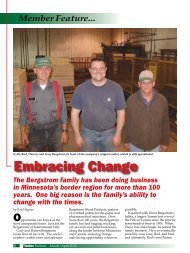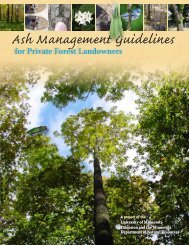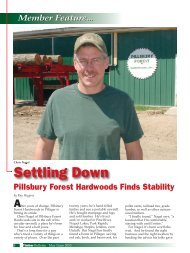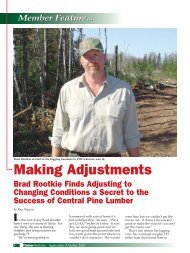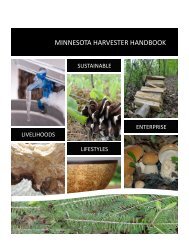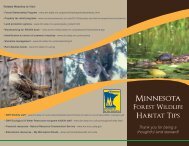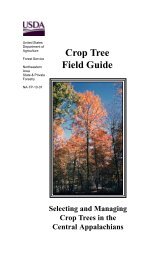Ash Management Guide for Private Forest Landowners
Ash Management Guide for Private Forest Landowners
Ash Management Guide for Private Forest Landowners
You also want an ePaper? Increase the reach of your titles
YUMPU automatically turns print PDFs into web optimized ePapers that Google loves.
The Emerald <strong>Ash</strong> Borer & Chestnut Blight: A historical perspectiveIf you have been a Minnesota resident during the pasthalf century, you likely remember the ‘great depression’ ofcommunity trees when Dutch Elm disease took its toll. Boulevardtrees, back yard trees, and trees along parkways andriverwalks had to be removed because of this disease thatvirtually wiped out the state’s elm tree population. There arelessons to be learned. Read on.Emerald ash borer is often compared with Dutch elmdisease. There are good reasons <strong>for</strong> this comparison. Minnesotanshave a cultural memory of the decline and lossof American elm in our cities. Dutch elm disease was firstdiscovered in St. Paul in 1961, with massive death of the treesand removal not occurring until the 1970s. Many communitiesreplaced at least some of their lost elms with ash. So it isnatural to make the comparison of emerald ash borer (EAB)to Dutch elm disease, particularly in our cities. But is thatreally a good comparison?Let’s look further back into our <strong>for</strong>est’s history <strong>for</strong> a differentexample: chestnut blight and the loss of American chestnut(Castena dentata). Chestnut blight led to the first largescale loss of a <strong>for</strong>est tree. American chestnut is a large, statelynative tree found from Maine to Mississippi. It succumbedalmost completely to chestnut blight between 1900, when theblight was first discovered in New Year City, and 1940 whenthe blight had invaded all the commercial stands of easternchestnut and killed most of the trees.So what is the impact of these pests on the <strong>for</strong>est? Emeraldash borer attacks and kills virtually all ash (Fraxinusspp.) trees greater than 1” in diameter. Chestnut blight, whilenot actually killing all the trees, reduced the presence of theAmerican chestnuts in the Appalachian <strong>for</strong>est to small bushlikesprouts growing from the truck and roots of <strong>for</strong>merlymajestic and dominate trees. This species is functionally lostto our <strong>for</strong>ests.Dutch elm disease, on the other hand, has a mortality rateof about 80%. While elm now makes up a significantly smallerpercent of our urban and <strong>for</strong>ested trees than be<strong>for</strong>e Dutchelm disease invaded, elm still exists in urban environmentslargely because of fungicidal treatments. In <strong>for</strong>ested environments,it remains as a small understory tree. This situationis very different than the functionally nonexistent Americanchestnut in the eastern <strong>for</strong>est. Additionally it is important tolook at the actual spread rate of these pests. Chestnut blightspread and killed chestnut trees at 32-40 km/year (Tainter& Baker, 1996). Actual spread rates <strong>for</strong> Dutch elm diseaseare harder to find, but it was first identified in Ohio in 1930and eventually arrived in St. Paul, Minnesota in 1961. Eventhen, the first seven years it was in St. Paul there were only 30reported cases.Emerald ash borer, on the other hand, was first reportedin Detroit, Michigan in 2002 – although dendrochronologicalanalysis places the insect there as early as the mid-1990s(Siegert, McCullough, Liebhold, Telewski, 2008). Dendrochronologyis the science of dating trees, and associatedenvironmental events, using a tree’s growth rings. In thiscircumstance, researchers in Michigan took ash trees fromvarious locations throughout southeastern Michigan, datedtheir growth rings, and noted the year of attack by EAB. Theythen cross referenced that data with weather patterns to betterassess when EAB first arrived in Michigan.Although its “first date” in the United States is still unknown,we do know EAB was here years be<strong>for</strong>e it was identifiedand reported, and be<strong>for</strong>e management and quarantineswere started.In a time span of about 15 years, EAB has spread to 14states from Minnesota to Virginia and Missouri to NewYork. Unlike chestnut blight, Dutch elm disease and EAB arebeing spread long distances in similar ways, mainly via humantransportation of wood materials. Chestnut blight wasspread predominately through natural movement. The futureprospect <strong>for</strong> ash is not bright. Data from Michigan indicatesthere is little residual ash in a stand after EAB has attackedan area, and the ash seed bank survives only up to eightyears. Scientists and volunteers have been working to collectand preserve ash genetic material in Minnesota <strong>for</strong> years sothat science will have genes from which to work after EABhas come through.<strong>Ash</strong> trees comprise over 50% of some stands in northernMinnesota. Conversely, elm, while an important tree speciesin several <strong>for</strong>est types, was almost never a majority of thetrees in a stand. And, in some <strong>for</strong>est stands in Appalachia,American chestnut comprised 25% of the trees. There<strong>for</strong>ethe stand-level impact of Dutch elm disease was likely lessthan the anticipated stand-level impact of EAB in some ashdominated sites in northern Minnesota. However, interestingly,ash now comprises a higher percent of some Minnesotantimber types than ever be<strong>for</strong>e, likely due to the loss ofelm. <strong>Ash</strong> filled the ecologic niche created when the elm died.It is ironic that one of the ten tree species in seven of the ninetimber types by geography recommended in this <strong>Guide</strong> is theintroduction of disease resistant American elm to replace ash.One could conjecture that the <strong>for</strong>est is coming full circle; oneinvasive species removed most elms from the <strong>for</strong>est to thebenefit of ash, now another invasive species will remove ashto the potential benefit of disease resistant elm.In summary, while Dutch elm disease was and is a major<strong>for</strong>est pest in Minnesota and was devastating <strong>for</strong> both theurban and <strong>for</strong>ested elms, emerald ash borer is likely to bean even bigger problem. It is expected to hit certain <strong>for</strong>eststands much harder than Dutch elm disease did – likely moreon the scale of American chestnut – something <strong>for</strong> which wehave virtually no living cultural memory.It is important to remember, however, that science is movingfaster than ever and genetic research has progressed markedlysince the turn of the century. <strong>Forest</strong>ers are now beginningto plant blight resistant American chestnuts in the <strong>for</strong>ests ofAppalachia, and there are disease resistant American elms wecan replant in our <strong>for</strong>ests. With careful monitoring, the help ofscience, and supportive funding the <strong>for</strong>est can grow again.For References, See Appendix D, page 665



